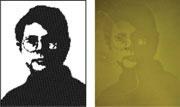 Paint me a picture
Paint me a pictureUsing parts from a toolkit developed by genetic engineers, a team of students has created light-sensitive bacteria that work as photographic film. It's an example of synthetic biology: a new way of thinking about life that owes as much to Henry Ford as Charles Darwin.
Engineers take it for granted that they can take a selection of screws, bolts and standard parts off the shelf to create whatever they want. Taking this approach to living systems might seem like science fiction. But it is exactly how students from the University of Texas built a bacterial-photography system for last year's Intercollegiate Genetically Engineered Machine competition at the Massachusetts Institute of Technology (MIT). The fruits of their labour are published in Nature1, and the team has since added to their invention for this year's competition (see 'Designs on life').
The team started with the well-known gut bacteria Escherichia coli, and, thinking like engineers, added extra 'parts' made at the University of California, San Francisco (UCSF). To make bacterial photography work, they needed to make E. coli respond to different levels of light by producing different amounts of a coloured substance. Then a film of the bacteria would work just like the film in a camera.
Paint me a picture
Habituated as it is to the dark insides of intestines, E. coli cannot detect light. So the first component the team needed was a light sensor.
“This kicks ass.”
Drew Endy
MIT.
One had already been designed at UCSF. The sensor consists of two parts: a protein from a blue-green alga called Synechocystis,which detects light, and a second protein, which switches a particular E. coli gene on and off. In normal E. coli, this gene is triggered by low water concentrations, and affects the surface membrane of the bug.
The next step was to swap this membrane-protein gene for something more useful: a gene that turns a certain chemical black.
The finished bacteria made their surroundings black unless they were exposed to light, at which point the light-sensitive switch turned off production of the blackening chemicals.
The more light, the less colour is produced, so that black and white photography is possible. A film of the bacteria can record an image at a high resolution of 100 megapixels per square inch.
The sum of its parts
"This kicks ass," says Drew Endy, a synthetic biologist at MIT, about the Texas students' success. "These kids aren't Nobel laureates, but they could take parts and make something like this in just a few months."
Instead of making black pigment, the bacteria could be redesigned to deposit proteins like spider silk, says Chris Voigt, leader of the UCSF lab that created the parts. Researchers in Voigt's lab are working on making bacteria produce different substances in response to different colours to make it possible to weave complex materials.
The parts made in Voigt's lab are available to anyone that wants them, thanks to the Registry of Standard Biological Parts at MIT. It's a toolkit for synthetic biologists that lists the different parts made, how they work, and how they can be linked to others.
Pastures new
ADVERTISEMENT
Other successes of synthetic biology include bacteria programmed with a biological clock to produce fluorescent pulses2, and others that can be told to exchange information encoded as DNA.
But Endy admits that the field is far from easy. "We are still bad at engineering biology," he says, "and what I want to know is how to get better at it."
Endy says that understanding how to make standard parts that can fit with any other will unlock synthetic biology's potential. "Screw threads are standardized so you know what you're getting," he says. "If we can develop standardized components of living sytems, we can concentrate on the design and engineering of new ones."
MIT.
